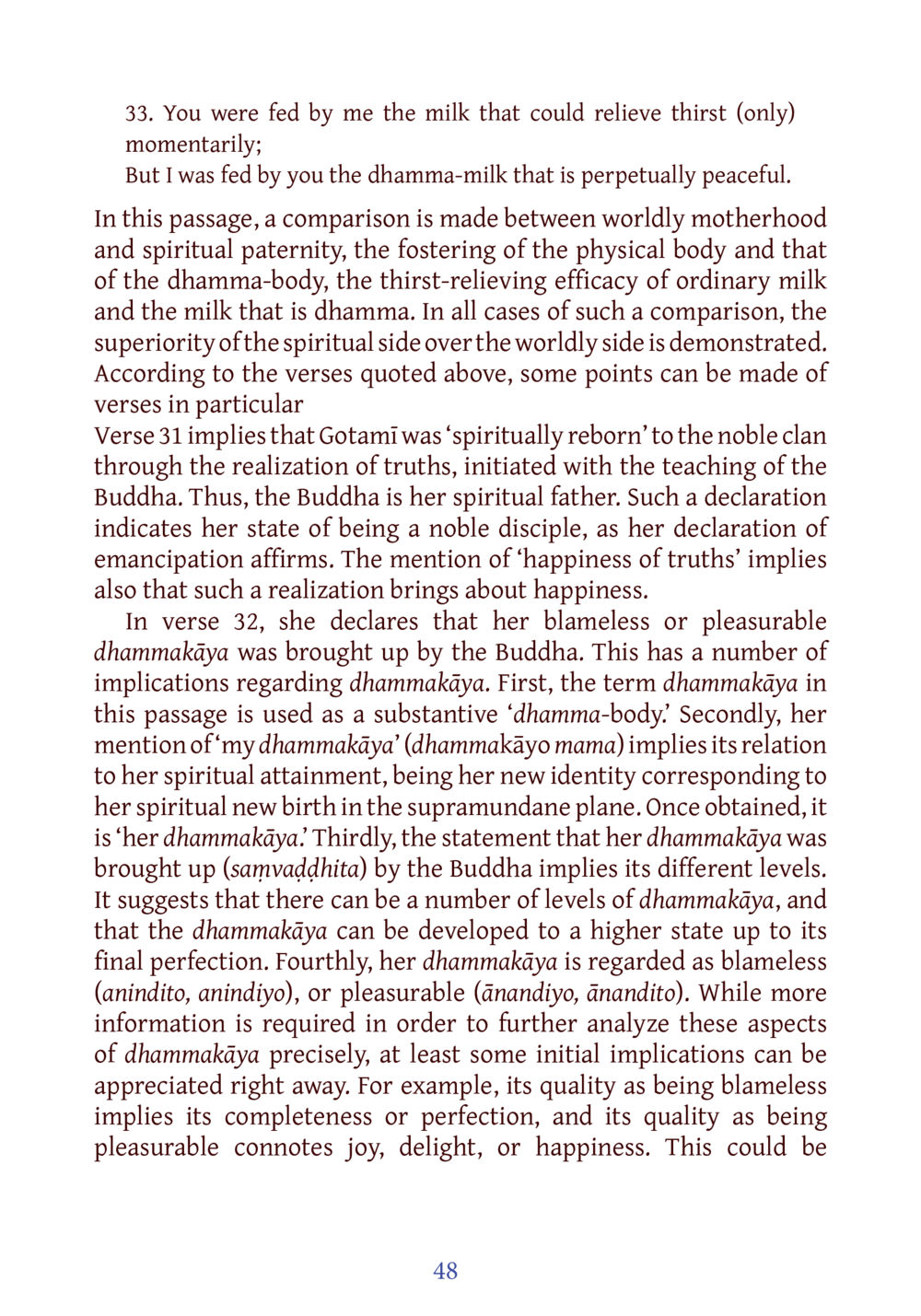The Superiority of Dhamma over Worldly Existence : หน้า 69/141
DIRI Journal : หน้า 69/141 Exploring the contrast between worldly motherhood and spiritual paternity, highlighting the significance of dhamma in achieving true happiness.
0 ครั้ง

สรุปเนื้อหา
ในบทความนี้เสนอการเปรียบเทียบระหว่างความเป็นแม่ในโลกกับการเป็นบิดาทางจิตวิญญาณ โดยเน้นที่การดูแลร่างกายทางกายภาพและร่างกายทางจิตวิญญาณ รวมถึงประสิทธิภาพในการบรรเทาความกระหายของนมธรรมดาและนมที่เป็น dhamma ความสำคัญของ dhamma ที่ส่งเสริมความสุขจากการตระหนักรู้ถึงความจริงและการเป็นศิษย์ที่ดีของพระพุทธเจ้านั้นถูกกล่าวถึง ผ่านการค้นพบ dhamma-body ซึ่งสำคัญไม่เพียงเพื่อการเจริญเติบโตทางจิตวิญญาณแต่ยังรวมถึงความสุขที่เกิดจากการตระหนักรู้.
หัวข้อประเด็น
-การเปรียบเทียบระหว่างความเป็นแม่และบิดาทางจิตวิญญาณ
-ความสำคัญของ dhamma
-การบรรลุ dhamma-body
-ความสุขจากการตระหนักรู้
-การเจริญเติบโตทางจิตวิญญาณ
ข้อความต้นฉบับในหน้า
33. You were fed by me the milk that could relieve thirst (only) momentarily; But I was fed by you the dhamma-milk that is perpetually peaceful. In this passage, a comparison is made between worldly motherhood and spiritual paternity, the fostering of the physical body and that of the dhamma-body, the thirst-relieving efficacy of ordinary milk and the milk that is dhamma. In all cases of such a comparison, the superiority of the spiritual side over the worldly side is demonstrated. According to the verses quoted above, some points can be made of verses in particular Verse 31 implies that Gotami was ‘spiritually reborn’ to the noble clan through the realization of truths, initiated with the teaching of the Buddha. Thus, the Buddha is her spiritual father. Such a declaration indicates her state of being a noble disciple, as her declaration of emancipation affirms. The mention of ‘happiness of truths’ implies also that such a realization brings about happiness. In verse 32, she declares that her blameless or pleasurable dhammakāya was brought up by the Buddha. This has a number of implications regarding dhammakāya. First, the term dhammakāya in this passage is used as a substantive ‘dhamma-body.’ Secondly, her mention of ‘my dhammakāya’ (dhamma káyo mama) implies its relation to her spiritual attainment, being her new identity corresponding to her spiritual new birth in the supramundane plane. Once obtained, it is ‘her dhammakāya.’ Thirdly, the statement that her dhammakāya was brought up (sāvaddhita) by the Buddha implies its different levels. It suggests that there can be a number of levels of dhammakāya, and that the dhammakāya can be developed to a higher state up to its final perfection. Fourthly, her dhammakāya is regarded as blameless (aninido, anindivo), or pleasurable (ānandiyo, ānindito). While more information is required in order to further analyze these aspects of dhammakāya precisely, at least some initial implications can be appreciated right away. For example, its quality as being blameless implies its completeness or perfection, and its quality as being pleasurable connotes joy, delight, or happiness. This could be
หน้าหนังสือทั้งหมด

1

2

3

4

5

6

7

8

9

10

11

12

13

14

15

16

17

18

19

20

21

22

23

24

25

26

27

28

29

30

31

32

33

34

35

36

37

38

39

40

41

42

43

44

45

46

47

48

49

50

51

52

53

54

55

56

57

58

59

60

61

62

63

64

65

66

67

68

69

70

71

72

73

74

75

76

77

78

79

80

81

82

83

84

85

86

87

88

89

90

91

92

93

94

95

96

97

98

99

100

101

102

103

104

105

106

107

108

109

110

111

112

113

114

115

116

117

118

119

120

121

122

123

124

125

126

127

128

129

130

131

132

133

134

135

136

137

138

139

140

141
หนังสือที่เกี่ยวข้อง
Load More
